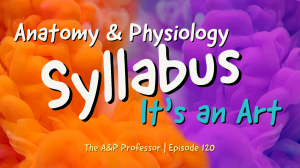In The Poop Episode, host Kevin Patton applies stories from his experience monitoring digestive health in zoo and circus animals to human anatomy and physiology. We explore the frequency of defecation, and how to read poop for common health issues. This is the episode that tells you how to get an elephant to poop on command!
00:00 | Introduction
01:08 | Getting Our 5#!+ in Order
07:42 | Zookeepers Know Their 5#!+
23:13 | Sponsored by AAA
24:18 | No Poop July
30:58 | Sponsored by HAPI
32:07 | Poop Reading
42:12 | Sponsored by HAPS
42:58 | We All Need to Know Our 5#!+
46:24 | Staying Connected
★ If you cannot see or activate the audio player, go to: theAPprofessor.org/podcast-episode-121.html
🏅 Apply for your credential (badge/certificate) for listening to this episode: theAPprofessor.org/podcast-episode-121.html/#badge
❓ Please take the anonymous survey: theAPprofessor.org/survey
☝️ Questions & Feedback: 1-833-LION-DEN (1-833-546-6336)
✔️ Follow The A&P Professor on Twitter, Facebook, Blogger, Revue, Tumblr, or Instagram! @theAPprofessor
📰 Get the thrice-weekly TAPP Science & Education Updates theAPprofessor.org/updates
Left foot, right foot, left foot, right.
Feet in the morning, feet at night.
Left foot, right foot, left foot, right.
Wet foot, dry foot, high foot, low foot.
Front feet, back feet, red feet, black feet.
Left foot, right foot. Feet, feet, feet, how many feet you meet. (Dr. Seuss)
Getting our 5#!+ in Order
6.5 minutes
If you are offended by the use of the term poop and its vulgar synonyms, this is not the episode for you. But then, isn't vulgar language "of the common people?"—exactly the folks we teach and to whom our students will be providing care?
★ The Foot Book (Bright & Early children's book by Dr. Seuss; can be read as The Poop Book) geni.us/afvGc
Zookeepers Know Their 5#!+
15.5 minutes
Zookeepers and other animal caregivers generally keep detailed poop journals that record defecation patterns and changes in stool from day to day. These journals can give insights on health over time and can spot potential problems before they get more serious. Monitoring human poop can have similar benefits.
★ CHOC Stool Diary AandP.info/4yq
★ Bowel Symptom Journal (from Alberta Health Services) AandP.info/6fw
★ Poop Apps: 5 Tools for Tracking Your Stools AandP.info/5ow
Sponsored by AAA
61 seconds
A searchable transcript for this episode, as well as the captioned audiogram of this episode, are sponsored by the American Association for Anatomy (AAA) at anatomy.org.
Don't forget—HAPS members get a deep discount on AAA membership!
No-Poop July
6.5 minutes
Holding poop back is possible. During A&P class, that's desirable. But too much poop-holding can cause problems.
★ ‘No poop July’ jokes are all over TikTok. Some doctors urge users not to try it for real. (from NBC News) AandP.info/d45
★ Why people should not hold in their poop (from Medical News Today) AandP.info/bzu
★ Why holding back your urge to poop can wreak havoc on your insides – a gastroenterologist explains (from The Conversation) AandP.info/8a2
Sponsored by HAPI Online Graduate Program
65 seconds
The Master of Science in Human Anatomy & Physiology Instruction—the MS-HAPI—is a graduate program for A&P teachers, especially for those who already have a graduate/professional degree. A combination of science courses (enough to qualify you to teach at the college level) and courses in contemporary instructional practice, this program helps you be your best in both on-campus and remote teaching. Kevin Patton is a faculty member in this program at Northeast College of Health Sciences. Check it out!
Poop Reading
10 minutes
Poop reading is monitoring poop for changes that potentially signal changes in health—especially digestive health. Some sample poop reading may help our A&P students integrate concepts and build problem-solving skills.
★ Poop 101: A beginner's guide to reading your own poop (from The Verge) AandP.info/bfu
★ Bathroom Reading: What You Can Learn from Your Poop (from Premier Health) AandP.info/mp2
★ Identifying Your Poop: What to Look For (from Healthline) AandP.info/t2i
Sponsored by HAPS
43 seconds
The Human Anatomy & Physiology Society (HAPS) is a sponsor of this podcast. You can help appreciate their support by clicking the link below and checking out the many resources and benefits found there. Watch for virtual town hall meetings and upcoming regional meetings!
We All Need to Know our 5#!+
3.5 minutes
We revisit the taboo of poop terminology, finish our discussion, and flush.
If the hyperlinks here are not active, go to TAPPradio.org to find the episode page.
★ More details at the episode page: theAPprofessor.org/podcast-episode-121.html
★ Transcript available in the transcript box: theAPprofessor.org/podcast-episode-121.html
★ Need help accessing resources locked behind a paywall? Check out this advice from Episode 32 to get what you need! my-ap.us/paywall
Take The A&P Professor experience to the next level!
★ theAPprofessor.org/community
Earn cash by referring other A&P faculty to this podcast:
Tools & Resources
★ TAPP Science & Education Updates: theAPprofessor.org/updates
★ Amazon: amzn.to/2r6Qa3J
★ Text Expander: theapprofessor.org/textexpander
★ Rev.com: try.rev.com/Cw2nZ
★ Snagit & Camtasia: techsmith.pxf.io/9MkPW
★ Krisp Free Noise-Cancelling App: theAPprofessor.org/krisp
★ JotForm (build forms for free): theAPprofessor.org/jotform
★ QuillBot (writing tools): theAPprofessor.org/quillbot
★ The A&P Professor Logo Items: https://www.teepublic.com/stores/the-a-p-professor
Sponsors
★ Transcript and captions for this episode are supported by the American Association for Anatomy | anatomy.org
★ The Human Anatomy & Physiology Society provides marketing support for this podcast | theAPprofessor.org/haps
★ Distribution of this episode is supported by the Northeast College of Health Sciences online graduate program in Human Anatomy & Physiology Instruction (HAPI) | northeast.edu/hapi
Clicking on sponsor links helps let them know you appreciate their support of this podcast!
Follow The A&P Professor on Twitter, Facebook, Blogger, Revue, Tumblr, or Instagram @theAPprofessor
The A&P Professor® and Lion Den® are registered trademarks of Lion Den Inc. (Kevin Patton)
As an Amazon Associate I earn from qualifying purchases. I may be compensated for links to sponsors and certain other links.
Click here to listen to this episode—or access the detailed notes and transcript.





